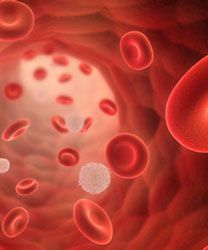Encouraging Responses Seen With Selinexor in Relapsed/Refractory DLBCL
According to findings from the phase IIb SADAL study, selinexor demonstrated deep and durable responses in patients with relapsed/refractory diffuse large B-cell lymphoma who are not candidates for autologous stem cell transplantation.

According to findings from the phase IIb SADAL study, selinexor demonstrated deep and durable responses in patients with relapsed/refractory diffuse large B-cell lymphoma (DLBCL) who are not candidates for autologous stem cell transplantation (ASCT).
In results reported at the 2018 ASH Annual Meeting by Marie Maerevoet, MD, the overall response rate (ORR) was 29.6% among patients enrolled on the trial, with a complete response (CR) rate of 9.6%. The response rates were 34.0% in patients with the germinal center B-cell (GCB) subtype and 21.1% in those with the non-GCB subtype.
The median overall survival was 9.1 months in the overall intent-to-treat (mITT) group, improving to 29.7 months in patients who achieved a CR or partial response (PR).
Maerevoet, senior researcher, Institute Jules Bordet, Brussels, Belgium, said treatment options are limited in this population and prognosis is poor. In November 2018, the FDA granted a fast track designation to selinexor for these patients based on results from SADAL.
“Life expectancy for these patients is only 3 months,” she said. “Responses to selinexor in this patient population are encouraging and highlight the potential of selinexor as a new treatment option for patients with relapsed/refractory DLBCL.”
Selinexor is an oral selective inhibitor of exportin 1 (XPO1), which is the major nuclear export protein for tumor suppressor proteins and eIF4E-bound oncoprotein RNAs. XPO1 inhibition via selinexor promotes nuclear localization of eIF4E and activation of tumor suppressor proteins relevant to Non-Hodgkin lymphoma including p53, p21, and IκBα, along with reductions in c-Myc and Bcl-2 oncogenes.
SADAL is an open-label, randomized phase IIb study comparing a 60 mg versus 100 mg of twice-weekly selinexor monotherapy administered in 28-day cycles.Eligible patients received 2 to 5 prior treatment regimens, and those who achieved a CR or a PR on prior therapy required an 8-week washout before enrolling into SADAL.
“The interim analysis in 2017 showed that the dose of 100 mg of selinexor was less well tolerated than 60 mg with similar efficacy,” said Maerevoet. “The study was amended to continue as single arm at a dose of 60 mg of selinexor.”
The mITT group included patients who discontinued selinexor due to toxicity or disease progression, or who had died. The mITT population formed the primary analysis population and was used for exploratory analyses of efficacy.
A total of 129 patients were enrolled as of November 15, 2018. Their median age was 67 years (range, 35-87) and the median time from their DLBCL diagnosis was 2.1 years (range, <1-16.2). Patients received a median of 2 prior lines of treatment (range, 1-6), and 31% had prior transplant. Sixty patients had GCB subtype, 63 had non-GCB, and 5 were unclassified.
Patients were evenly split between good prognosis (45%) and poor prognosis (46%) by the Revised-International Prognostic Index (2% were very good and 7% were unknown). One hundred fifteen patients have been evaluated for response.
In addition to the 11 patients who achieved CR, 23 (20.0%) achieved PR and 8 (7.0%) had stable disease (SD). Among the 34 responders, the median duration of response (DOR) was 9.2 months (95% CI, 4.9-23.0). The median DOR was 23.0 months (95% CI, 4.9-23.0) among those who achieved CR and 7.8 months in those with PR (95% CI, 2.8-NE).
Seven of the 11 patients who achieved a CR are still on treatment. Forty-six patients with a post-baseline response reading had reductions in tumor burden.
Among patients with the GCB subtype, 5 (9.4%) had a CR, 13 (24.5%) had PR, and 5 (9.4%) had SD. Among those with the non-GCB subtype, the corresponding rates were 10.5%, 10.5%, and 5.3%, respectively.
The most common nonhematologic treatment-related adverse events (TEAEs) were gastrointestinal and constitutional, and included nausea (50%), fatigue (35.9%), anorexia (32.0%), vomiting (22.7%), diarrhea (21.9%), and weight loss (21.1%). The vast majority of these were grade 1/2. Hematologic TEAEs observed were thrombocytopenia (49.2% total; 35.2% grade 3/4), anemia (28.1% total; 11.0% grade 3/4), and neutropenia (25.8% total; 20.3% grade 3/4).
In October 2018, the FDA granted a priority review to a new drug application (NDA) for selinexor for the treatment of patients with penta-refractory multiple myeloma. Under the Prescription Drug User Fee Act, the FDA is scheduled to make a decision on the application by April 6, 2019.
The NDA is based on data from the phase IIb STORM study, which examined the combination of selinexor and dexamethasone. Updated findings presented at the 2018 SOHO Annual Meeting showed that the combination was associated with an ORR of 26.2% and a median overall survival of 8.6 months in patients with penta-refractory disease.2
References:
- Maerevoet M, Vermaat J, Canales MA, et al. Single agent oral selinexor demonstrates deep and durable responses in relapsed/refractory diffuse large B-cell lymphoma (DLBCL) in both GCB and non-GCB subtypes: the phase 2b SADAL study. Presented at: 2018 ASH Annual Meeting; Dec. 1-4, 2018; San Diego, CA. Abstract 1677.
- Jagannath J, Vogl DT, Dimopoulos MA, et al. Phase 2b results of the STORM study: oral selinexor plus low dose dexamethasone (sd) in patients with penta-refractory myeloma (penta-MM).Clin Lymphoma Myeloma Leuk. 2018;18(suppl; Abstract MM-255). doi: 10.1016/j.clml.2018.07.149.
Examining the Non-Hodgkin Lymphoma Treatment Paradigm
July 15th 2022In season 3, episode 6 of Targeted Talks, Yazan Samhouri, MD, discusses the exciting new agents for the treatment of non-Hodgkin lymphoma, the clinical trials that support their use, and hopes for the future of treatment.
Listen